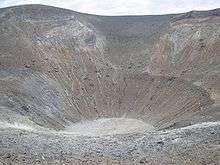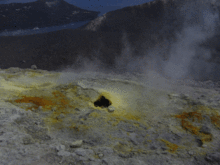Vulcano
| Vulcano | |
|---|---|
 View of Vulcano from the island of Lipari. | |
| Highest point | |
| Elevation | 501 m (1,644 ft) |
| Prominence | 501 m (1,644 ft) |
| Coordinates | 38°24′15″N 14°57′57″E / 38.4042°N 14.9658°ECoordinates: 38°24′15″N 14°57′57″E / 38.4042°N 14.9658°E |
| Geography | |
 Vulcano and the Aeolian Islands. | |
| Location | Aeolian Islands, Italy |
| Geology | |
| Mountain type | Complex stratovolcanoes |
| Last eruption | 1888 to 1890 |

Vulcano (Sicilian: Vurcanu) is a small volcanic island in the Tyrrhenian Sea, about 25 km (16 mi) north of Sicily and the southernmost of the eight Aeolian Islands. It is 21 km2 (8 sq mi) in area, rises to 499 m (1,637 ft) above sea level, and contains several volcanic centers, including one of four active non-submarine volcanoes in Italy.
History
The Romans used the island mainly for raw materials, harvesting wood and mining alum and sulfur. This was the principal activity on the island until the end of the 19th Century.
When the Bourbon rule collapsed in 1860 (see Francis II of the Two Sicilies) a British man named James Stevenson bought the northern part of the island, built a villa, reopened the local mines and planted vineyards for grapes that would later be used to make Malmsey wine. Stevenson lived on Vulcano until the last major eruption on the island, in 1888. The eruption lasted the better part of two years, by which time Stevenson had sold all of his property to the local populace, and never returned to the island. The villa is still intact.
Currently, around 470 people live on the island, mainly deriving their income from tourism. It is a few minutes hydrofoil ride from Lipari and has several hotels and cafes, the important attractions being the beaches, hot springs and sulfur mud baths.
Geology

The volcanic activity in the region is largely the result of the northward-moving African Plate meeting the Eurasian Plate. There are three volcanic centres on the island:
- At the southern end of the island are old stratovolcano cones, Monte Aria (501 m), Monte Saraceno (481 m) and Monte Luccia (188 m), which have partially collapsed into the Il Piano Caldera.
- The most recently active centre is the Gran Cratere at the top of the Fossa cone, the cone having grown in the Lentia Caldera in the middle of the island, and has had at least 9 major eruptions in the last 6000 years.
- At the north of the island is Vulcanello, 123 metres high, and is connected to the rest of it by an isthmus which is flooded in bad weather. It emerged from the sea during an eruption in 183 BC as a separate islet. Occasional eruptions from its three cones with both pyroclastic flow deposits and lavas occurred from then until 1550, the last eruption creating a narrow isthmus connecting it to Vulcano.
Vulcano has been quiet since the eruption of the Fossa cone on 3 August 1888 to 1890, which deposited about 5 metres of pyroclastic material on the summit. The style of eruption seen on the Fossa cone is called a Vulcanian eruption, being the explosive emission of pyroclastic fragments of viscous magmas caused by the high viscosity preventing gases from escaping easily. This eruption of Vulcano was carefully documented at the time by Giuseppe Mercalli. Mercalli described the eruptions as "...Explosions sounding like a cannon at irregular intervals..." As a result, vulcanian eruptions are based on this description. A typical vulcanian eruption can hurl blocks of solid material several hundreds of metres from the vent. Mercalli reported blocks from the 1888-1890 eruption fell in the sea between Vulcano and Lipari, several were photographed by him or his assistants that had fallen on the island of Vulcano.

Mythology
The Ancient Greeks named the island Therassía (Θηρασία) and Thérmessa (Θέρμεσσα, source of heat). The island appeared in their myths as the private workshop of the Olympian god Hephaestus, protector of the blacksmiths; he owned another two at Etna and Olympus. Strabo also mentions Thermessa as sacred place of Hephaestus (ἱερὰ Ἡφαίστου), but it is not clear if it was a third name for the island, or just an adjective.[1]
Similarly the Romans believed that Vulcano was the chimney of the god Vulcan's workshop and therefore named the island after him. The island had grown due to his periodic clearing of cinders and ashes from his forge. The earthquakes that either preceded or accompanied the explosions of ash were considered to be due to Vulcan making weapons for Mars and his armies to wage war.[2]

Science
Since Vulcano island has volcanic activity, this island is a place where thermophiles and hyperthermophiles are likely to be found. In fact, the hyperthermophilic archaea Pyrococcus furiosus was described for the first time when it was isolated from sediments of this island by Gerhard Fiala and Karl Stetter.[3]
See also
- List of volcanoes in Italy
- Vulcan (mythology)
- Vulcano a 1950 Italian drama film supposedly set on the island.
References
- ↑ Strabo Geographica 1.2.10
- ↑ "CVO Menu - Volcanoes in Historical and Popular Culture". Vulcan.wr.usgs.gov. Retrieved 2013-08-26.
- ↑ Fiala, G., & Stetter, K. O. (1986). Pyrococcus furiosus sp. nov. represents a novel genus of marine heterotrophic archaebacteria growing optimally at 100 °C (212 °F). Archives of Microbiology, 145, 56–61.
- Ezio Giunta, dir. (2005). "Vulcano". Estateolie 2005*The Essential Guide (English version of Tourist Guidebook): 80–87.
- "Vulcano". Global Volcanism Program. Smithsonian Institution. Retrieved 2008-12-18.
External links
| Wikimedia Commons has media related to Vulcano (Isola). |
| Wikivoyage has a travel guide for Vulcano. |